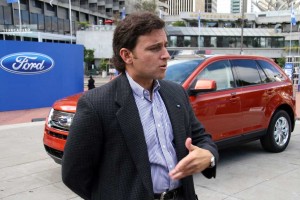
Ford's decision to skip a federal bailout certainly hasn't hurt sales, says the automaker's president, Mark Fields.
The U.S. new car market is bound to recover…someday. But so far, it has defied predictions of a turnaround and continues operating at levels not seen in decades – volumes down nearly 50% from the record sales of the early part of this decade. Surprisingly few makers have escaped the impact of the slump, though a few have some positive stories to tell.
While Ford, for example, is down overall, its retail share has actually been up a bit, year-over-year. Why? Well, there are several possible explanations, including the automaker’s risky decision to reject a federal bailout, even as Washington tossed tens of billions at its cross-town rivals.
TheDetroitBureau.com posed that and several other questions to 49-year-old Mark Fields, Ford’s President of the Americas, during today’s media preview of the automaker’s 2010 product line-up. Jump to the next page to see what he has to say.
TheDetroitBureau: We’ve just posted a story looking at the challenges Detroit makers face regaining share in the coastal markets, especially California. Is it fair to say it won’t be easy?
Fields: We’ve actually made a lot of progress with our (Ford’s) retail market share in California compared to two years ago. A lot of that is due to the new F-150. People forget that California is not just big cities like Los Angeles and San Francisco, but that it is a big agricultural market. So, 18 months ago, we changed our marketing strategy. Rather than focus on our entire product line, we decided to highlight vehicles new to Ford, like the (redesigned) F-Series and Edge, and emphasize factors like quality, reliability and fuel economy. So, while has been known, in California, as a work brand, it’s now also seen as a brand you can play in, as well. We also biased some of our launches towards California by bringing more vehicles out there earlier.
TheDetroitBureau: There were some early indications that June was going to be a strong month for the U.S. market, overall, but things slowed down, some said, because of the debate, in Congress, over the cash-for-clunkers bill. Now that it’s in place, what’s happening in the marketplace?
Fields: Over the last couple months, on the retail side, we’ve seen some stabilization. Combine that with the latest indices, on things like jobs, consumer confidence and the like and we think things are starting to move in the right direction. We think we’ve hit bottom. The clunkers bill delivers one of the first positive messages in months to the consumer to come in and take a look at the new cars. All-in-all, we’re cautiously optimistic. The question is when things will start to grow again, and how significantly?
TheDetroitBureau: Ford has been doing a bit better than its cross-town rivals, so far this year. Why?
Fields: When you look at our market share, the last few months, our retail share is up. People have started noticing our products because of improving quality, as well as their design and new technology. The new Fusion has been a big help, and the redesigned F-150 has been well-received. Even the Flex has been gaining share, month by month. What’s significant is that we’re bringing new buyers into the brand. This year, 54% of our Fusion buyers didn’t come out of another Ford vehicle.
TheDetroitBureau: Some analysts suggest Ford has benefited from the fact that it decided to decline a federal bailout. That was a risky move, wasn’t it?
Fields: We realized we had sufficient liquidity to keep ourselves funded through the downturn – and not just our day-to-day operations, but to fund our product development. Our pipeline, as you can see, is very full. We saw it (not taking a bailout) as an opportunity. Clearly, by not taking government money, we’re hearing, anecdotally, from our dealers that people are coming into showrooms saying they were pleased by our decision. It has given us the opportunity to talk about our great product, and that’s the primary reason people are coming into our showrooms.
TheDetroitBureau: So, there is a bit of a payoff:
Fields: These days, it’s all about value. That’s what customers are looking for. But the cherry on top is that people realize we’re doing it on our own and not asking for government dollars.
